Places Visited: Louisiana: Lafayette
Texas: Amarillo, Palo Duro
Canyon, Red River Valley, Quanah, Goodlett, Mineola, & Traveling across north
Texas
Wednesday, May 31 2006: We camped in Acadiana Park (City of Lafayette,
LA) N30° 15.43 W91° 59.354' from I-10 take exit 104 south to first traffic
signal then left/east on Alexander to park entrance (approximately one mile).
The campground is heavily wooded with paved interior roads & pads, 50-amps,
water with central dump station, $13 per-night:
We have been home
(in Pensacola) since early March. We have had a good time with our Son, Daughter
in Law and Grand Children but it is time to head out to explore more of this wonderful
country. It finally turned hot in Pensacola and that made it much easier to escape
to a cooler location (as in Idaho). We had been packing and otherwise getting
ready to head out for several weeks, finally around 9-AM this morning we pulled
out of our driveway and headed west.
Our route was along I-10 out of Florida,
through Alabama and Mississippi and half way through Louisiana, to Lafayette,
where we stopped at one of our favorite campgrounds, Acadiana City Park in Lafayette.
The park is nothing special unless you are a cheap skate like I am. Acadiana City
Park offers a campsite under wonderful large shade trees with water and 50-amps---50-amps
is something that is really, really nice when it is 90-degrees outside and humidity
very near that. The shade is equally wonderful.
The only thing of note
on our drive was the three alligators I spotted from the bridge over Mobile Bay.
I have never spotted more than one per-crossing so this was a record. Once in
Lafayette we drove our Saturn to "Rookery Road" on Lake Martin. To our
total surprise we did not see the first heron in the rookery nor did we see any
alligators. We are not sure what to make of this since we have seen herons in
this rookery in the spring and last year we saw them when we passed through the
area near the end of June. It was dryer than we have ever seen it but there was
still water in the lake.
Thursday, June 1 2006: We camped in Mineola, Texas
at Golden RV-Park about 5-miles west of town on US-69 N32° 43.459 W95°
32.508'. Golden RV-Park was carved out of an old pasture (trees are limited) gravel
interior roads & grass pads, 50-amps, water and sewer, $25 per-night 903-766-2655.
This campground was an OK overnight stop if passing through the area and needing
to connect to utilities.
We drove 315-miles from Lafayette, Louisiana to
Mineola, Texas today mostly on interstate highways. From Lafayette we headed north
on I-49 to Shreveport where we headed west for a few miles on I-20 until we exited
to US-80 then in Mineola we switched to US-69. The only BAD stretch of highway
was the bypass in Shreveport (Inner Loop Louisiana 3121). While Inner Loop SR-3121
was only about 12-miles it was simply horrible. It reminded us of how bad the
old I-10 used to be. I had to slow to 45-miles per-hour and even that was bouncing
the motorhome in a terrible manner. Mercifully, we exited SR-3121 on to I-20 before
the motorhome broke in half.
Louisiana was lush and green. We transitioned
from rice fields with crawfish ponds just north of Lafayette to cattle ranches
and forested terrain as we transitioned to northwestern Louisiana. Pine trees
seemed to dominate the woodlands in the rolling hills of NW Louisiana and NE Texas.
Agriculture and row crops were becoming more common as we headed west in Texas.
Friday,
June 2 2006: We stopped for the night in Goodlett (Quanah), Texas at Old Town
Cotton Gin RV-Park on the east side of town on Main Street N34° 20.136 W99°
52.903'. The Old Town Cotton Gin RV-Park is carved out of an old pasture (trees
are limited) gravel interior roads & pads, 50-amps, water, cable TV and sewer,
$21.60 per-night 940-674-2477.
While we stopped for the night in Quanah,
Texas we spent the day traveling 306-miles west across northern Texas very near
the Red River and the Oklahoma border. As we left northeast Texas this morning
the countryside was bright green, as in well watered. Untilled land was forested
with hardwoods and pine trees. Harvesters were busy harvesting vast fields of
golden grain. Lush fields of corn were visible early in the day. Oil wells with
those "chicken-head" pumps were visible from time to time all day. The
further west we traveled the trees began to change to cedar and post oak trees,
with mimosa trees in full bloom. Still further west cottonwood trees, mesquite
trees, cattle trucks and Dance Halls became common. Fences started being made
out of discarded oil industry pipe and signs for German Sausage became common.
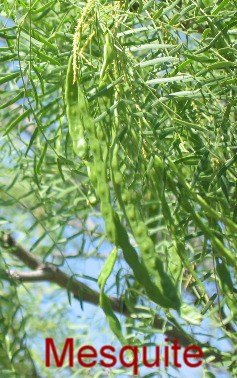
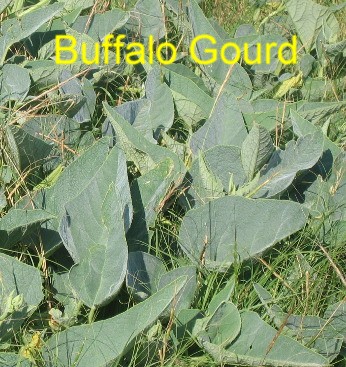
By
the time we stopped for the night we were 160-miles east of Amarillo. In this
area of north Texas we are in a dryer geography than we left this morning in east
Texas. Scissors tail flycatchers and meadow larks are common. We watched a group
of seven Mississippi kites working over a field of small mesquite trees. This
far west we are starting to see yucca plants, mesquite, desert willow, white prickly
poppy, buffalo gourds and cactus. Cattle ranches and freshly tilled cotton fields
dominate the landscape.
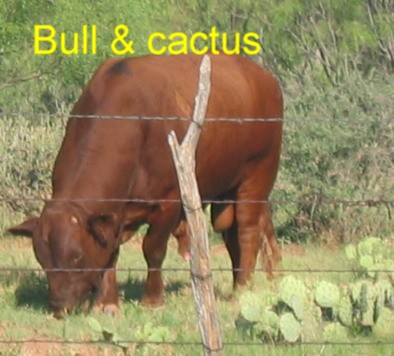
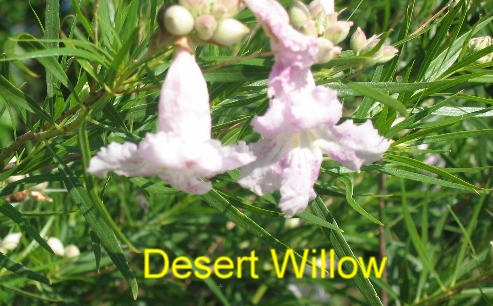
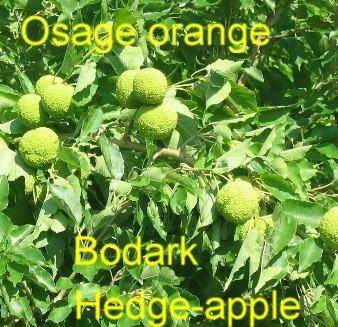
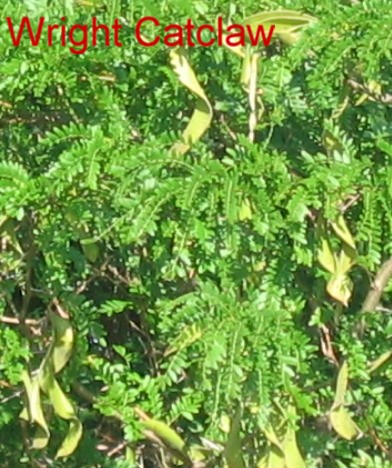
On
a sightseeing drive on Farm 680 near the Old Town Cotton Gin RV-Park we ran across
a grove of wright catclaw trees mixed with osage orange/bodark trees. We are a
little west of the normal range for bodark trees and a bit north of the normal
range for wright catclaw trees.
I think this area
is referred to as the Red River Valley since the Red River is about 10-miles north
of the RV-Park where it forms the border between Texas and Oklahoma. Our sightseeing
drive took us over the Red River into Oklahoma. If you visit this area take a
sightseeing drive up Farm 680 to the Oklahoma border and an ancient wooden bridge
across the Red River. If you take this drive around sunset you will see numerous
deer. During the day look for flocks of turkey and bob white quail along the way.
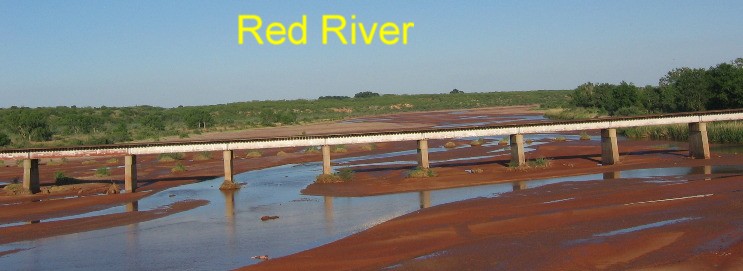
You
can also cross the Red River on SR-6 that runs north out of Quanah, Texas. Most
of the river bed was exposed as red clay with a small stream of water trickling
through. The dry channel looked to be several hundred yards wide. Bridges across
the Red River were constructed to allow flood waters to flow underneath in stark
contrast to the mere trickle of water in the river now. The owner of the RV-Park
told us the river ran underground in the sand.
The Old Town Cotton Gin
RV-Park uses Quanah, Texas as their address although the town of Quanah is located
10-miles east of the campground. Quanah was named after Quanah Parker, Chief of
the Kwahadi (Antelope) Camanches. He refused to sign the reservation treaty of
1865 (Civil War era) and remained on the buffalo plains in peace until 1870, when
hide hunters moved in. In 1874 his years of resisting the whites were climaxed
at the battle of Palo Duro which brought defeat and eventual reservation life
for the Comanches. On the reservation Quanah became a great leader where he learned
the new ways and became a successful rancher. While the battle of Palo Duro Canyon
only resulted in the death of one soldier with 14 Indians wounded and five Indians
killed the military commander, Colonel Mackenzie's army captured about 1,400 horses
from the Indians. To prevent the Indians from recovering this herd of horses,
Mackenzie had his men shoot over a thousand of them. Without their large horse
herd, the Southern Plains tribes lost their mobility and had no choice but to
surrender. Now you know why these Plains Indians finally surrendered.
We
were traveling on US-highways not part of the interstate system. Texas provides
wayside parks and picnic areas along these highways. While these wayside/picnic
areas generally do not have rest rooms they do provide shelters with tables water
and garbage cans generally located in a shaded area. These wayside parks are widely
used across the state. Other states would do well to copy Texas lead with these
picnic areas.
As we passed one dance hall we both started laughing. It was
before noon and the parking lot of the dance hall had 4-cattle trucks and one
motorhome in the parking lot. We laughed that they were getting an early start
on Friday night.
Saturday, June 3 2006: We stopped for the night in Amarillo,
Texas at Wonderland RV-Park on the north side of town off US-287 N35° 14.082
W101° 49.975'. There is nothing special about Wonderland RV-Park other than
price and location for us gravel interior roads & pads, 50-amps, water, WIFI
and sewer, $23.40 per-night 806-383-1700.
We drove the 160-miles to Amarillo,
Texas across the Red River Valley and plowed fields ready to plant cotton. Trees
in this area are small and sparse. Freshly plowed fields made the landscape. We
were stopping in Amarillo to visit Palo Duro Canyon State Park 35-miles south
of Amarillo. Many fellow RV'ers have recommended Palo Duro Canyon State Park over
the years so we made it a priority to visit on our way to Idaho this summer. While
there are several campgrounds in Palo Duro Canyon and we originally intended to
camp there but made a decision to stay in Amarillo to save money. By not taking
the motorhome to the canyon we saved around 11-gallons of diesel currently costing
almost $3 per-gallon.
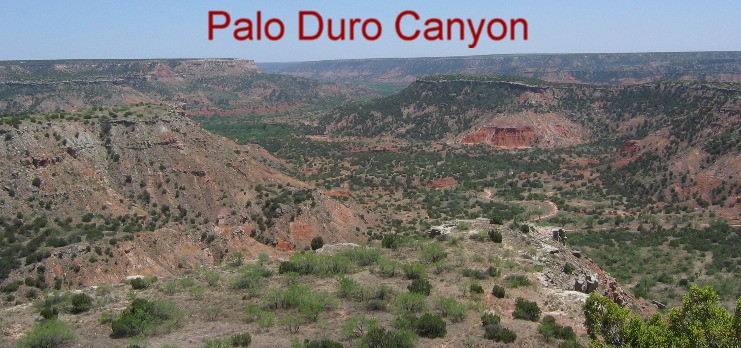
As
soon as we checked into Wonderland RV-Park we jumped into our Saturn and headed
to Palo Duro Canyon. We didn't know what to expect except something very special.
As we turned east off I-27 on SR-217 that goes to the canyon we noticed how flat
the land was. The rolling hills had given away to an extremely flat landscape
that gently sloped to the east toward Palo Duro Canyon. In this bleak landscape,
where you can see forever, it is hard to visualize a canyon but about 10-miles
down that road we entered Palo Duro Canyon State Park and there was this magnificent
canyon. The canyon has been cut by the Prairie Dog Town Fork of the Red River,
a small river that cuts through the landscape on its way to the Oklahoma border
just north of the RV-Park we stayed in last night in Goodlett, Texas where the
Prairie Dog Town Fork of the Red River becomes the Red River.
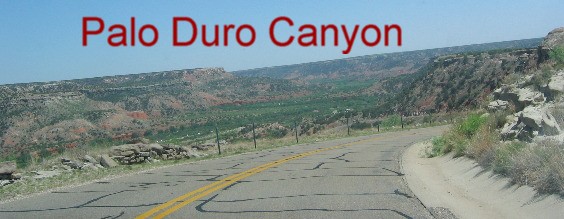
The
entrance to Palo Duro Canyon State Park is located at the top of the canyon. In
1933 the CCC constructed the current road down the side of the canyon wall into
the canyon. Several hundred men were involved in constructing the one and a half
mile road from the canyon rim to the floor. While difficult areas were blasted
away with dynamite, the vast majority of the construction was accomplished with
hand tools such as picks, shovels, and wheelbarrows. In less than six months,
these hardworking individuals had succeeded in creating the first vehicle access
to the canyon floor. Signs on that road say it is a 10% grade. That should be
very exciting for RV'ers. The view going down the this road is spectacular.
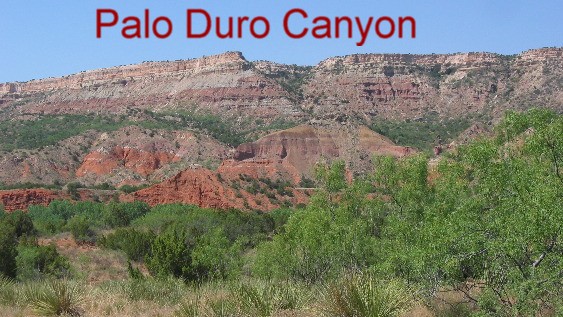
The
river has been cutting through this canyon for millions of years exposing layers
of soil deposited over 250-million years ago. Animals and people have been inhabiting
this canyon since the beginning of time. Fossils from animals inhabiting this
valley eons ago are on display in the Park's Visitor Center. When you look at
our pictures realize that the red clay layer is from the Permian Age (over 250-million
years ago).
In 1916, the Texas Panhandle was
barely out of the days of the wild west. Settlers were adjusting to new lifestyles
of barbed wire fences and railroads. One of these men was Colonel Charles Goodnight.
Goodnight is an important figure in the history of the Texas Panhandle. He was
a scout for the U.S. Army during the Indian wars in Texas. In 1876, he and his
partner John Adair came to Palo Duro Canyon and founded the J.A. Ranch, the first
true cattle ranch in the panhandle. Charles befriended many native Americans who
were forced to live on reservations, and invited them to hunt buffalo on his ranch,
just like in the old days.
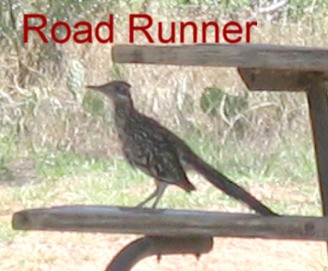
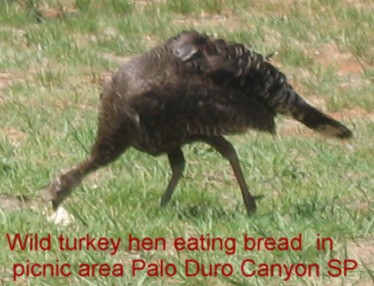
Once
in the canyon the road twists and turns for 16-miles past multiple campgrounds
and picnic areas, equestrian areas, hiking trails and riding trails. We drove
through every place we could find looking for scenery and wildlife. It was so
hot, as in the 90's, so we did not get out and hike. We saw road runners and several
turkey hens utilizing the shelters for shade in picnic areas.
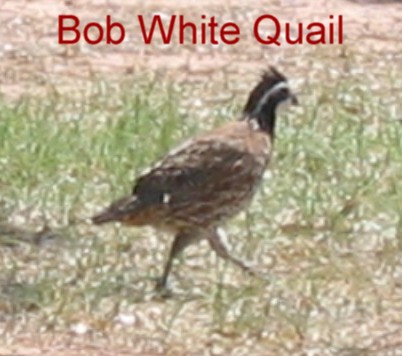

Bob
white quail and northern oriole were also visible in the campgrounds and picnic
areas. Mesquite is the predominant tree in the canyon.
Until
next week just remember how good life is.
Mike & Joyce Hendrix